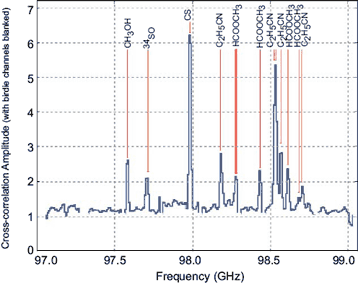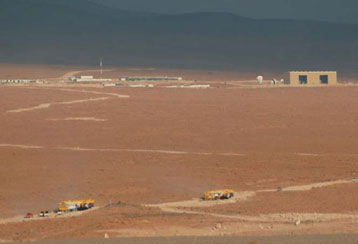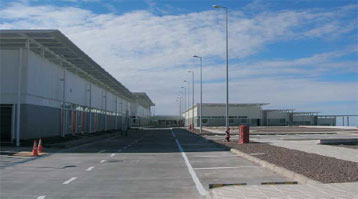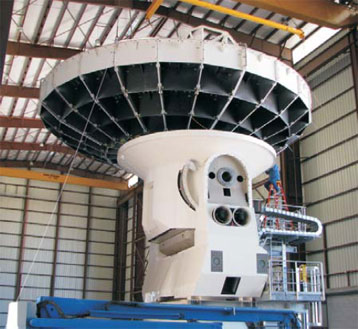NRAO eNews
October 2008 • Vol. 1, Iss. 5
- The Expansion of Supernova Remnant G21.5–0.9: Is PSR J1833–1034 the Youngest Pulsar?
- Discovery of a Small Group Driving the Evolution of an Edge-On Spiral Galaxy
- Cosmic Rays and the Magnetic Field in the Nearby Starburst Galaxy NGC 253
- Neutral Hydrogen Clouds in the M81/M82 Group
- ALMA Project Progress
- North American ALMA Science Center
- The ALMA Spectral Line Catalog
- The Birth and Feedback of Massive Stars, Within and Beyond the Galaxy: The NAASC Science Workshop for 2008
- Current Status
- VLA Configuration Schedule, Proposals, and Scheduling
- VLBA and HSA Proposals and Scheduling
- Global cm VLBI Proposals
- VLA and EVLA Spectral Line Observations Below 1200 MHz
- Status of Observing with the Transition Array
- VLBA Sensitivity Upgrade Project
- First 3mm Science Observations with the GBT and MUSTANG Call for Proposals
- The GBT Dynamic Scheduling System Update
- Progress on the Ka-Band Focal Plane Array for the GBT
- Opportunities for University-Led Technical Development Projects in Green Bank
- New NRAO Website Debuts
- The NRAO at the American Astronomical Society and American Association for the Advancement of Science Meetings
- Call for GBT Shared-Risk MUSTANG Proposals
- Large Proposals to Use NRAO Telescopes
- Chris Carilli Appointed Observatory Chief Scientist
- Eleventh Synthesis Imaging Workshop
- 2008 Grote Reber Medal Awarded to Sandy Weinreb
- NRAO Participates in the BEYA Conference
- NRAO Business Managers Meet in Chile
- NRAO Library News
- Past Issues
- Contact the Editor
- Subscribe
- More Information
NRAO Newsletter • April 2008 • Issue 115
ALMA Project ProgressThe fifth anniversary of the February 23, 2003 signing of the Agreement concerning the Joint Construction and Operation of the Atacama Large Millimeter Array (ALMA) saw the project entering the last year before commissioning observations will commence. In December, the U. S. Congress enacted the FY2008 budget, which provided funding for the seventh year of ALMA construction at the level requested by the National Science Foundation. In early February, the President requested funding for FY2009, the eighth year of this eleven year project. In preparation for deployment of the first stations of the array next year, the infrastructure at the mid-level and high altitude sites has reached a mature state and components of the array continue to stream to the ALMA sites around the world. The Proceedings of the November 2006 ALMA Conference in Madrid, Science with the Atacama Large Millimeter Array: A New Era for Astrophysics, has been published by Astrophysics and Space Science as Volume 313, Numbers 1–3, dated January 2008. This volume gives a wide-ranging overview of the types of science ALMA will produce. 
Figure 1. The first spectrum obtained with the ALMA prototype antennas at the ALMA Test Facility used the evaluation receivers and production backend equipment. Blanked channels represent missing data. 
Figure 2. The huge ALMA antenna transporters, foreground, arrived at the Operations Support Facility, background, on February 14, 2008. 
Figure 3. Construction on the OSF technical facility complex has been completed. The antenna assembly building (left) and technical building (right) are shown here. 
Figure 4. The antenna transporters travel through the Cordillera del Sal toward San Pedro de Atacama, lying just beyond, and the ALMA operations site, to the right of this image on the flanks of the Andes. Licancabur is to the right. 
Figure 5. The pedestal for Vertex Antenna No. 3 and the backup structure have now been mated. VertexRSI antenna No 2, fully assembled, is in the Site Erection Facility. Software and hardware components of ALMA have been under test at the ALMA Test Facility (ATF) in New Mexico. As these tests reach maturity this site will close and final testing of production components will occur at the Operations Support Facility near San Pedro de Atacama in Chile. Highlights of the recent testing in New Mexico have included continued routine interferometry. A recently installed scaled down version of the main correlator was installed last year; in January this produced its first interferometric spectrum, shown in Figure 1, taken in the lowest resolution mode of the correlator. Single antenna spectra of the SiO maser line at 86 GHz were also obtained, to test spectral line pointing of individual antennas. Production equipment continues to arrive at the ALMA sites. The correlator for the Atacama Compact Array was installed in the Array Operations Site Technical Building (AOS TB) at 5000m elevation by personnel from the National Astronomical Observatory of Japan late in 2007. Excavation for the antenna stations has begun near the AOS TB. At the 2900m altitude of the Operations Support Facility, the Technical Building (OSF TB) complex construction was completed (left of Figure 2). The third VertexRSI antenna was delivered and assembled in the Site Erection Facility (SEF, right, Figure 2) while acceptance testing of the first of these antennas began (this antenna is situated to the left of the SEF in Figure 2). The fourth VertexRSI antenna is en route to Chile as this is being written. Adjacent to this facility lies the Mitsubishi antenna erection area, to which the fourth and final Mitsubishi 12m antenna was delivered at year’s end. Acceptance tests of the first of these antennas are well along. At the close of 2007, seven ALMA telescopes have been delivered to Chile, about one tenth of the total. As they are accepted, antennas will be moved to the grounds of the OSF TB where they will be outfitted with production equipment, including the receiver packages, and tested in a continuation of the activities currently under way at the ATF. The antennas will be moved by one of the two transporters, capable of lifting antennas weighing 115 tons and placing them on foundations with a precision of millimeters. Both of these machines, weighing 130 tons each, embarked from the Scheuerle Fahrzeugfabrik GMBH factory and embarked on their journey to port at Heilbronn, Germany. These behemoths, named Otto and Loge at a ceremony last October, travel on 28 tires and extend 30 feet in width and 60 feet long; they are 18 feet high. They were transferred to a barge to continue the journey down the Neckar River past Heidelberg to the Rhine, then down the Rhine to Antwerp, Belgium. By December 11, they had arrived in Antwerp, where they were transferred to an ocean vessel that arrived in port at Mejillones, Chile on February 7. On February 14, 2008 they completed their journey to the ALMA operations base camp at 9600 ft elevation, where they were within sight of their intended cargo, the seven antennas now at the OSF, for the first time. After a few months of testing, they will move the first antenna accepted to an antenna foundation at the just-finished OSF TB for early antenna testing. Eventually these two welltraveled giants will move the antennas to the 16400 foot level at which ALMA observes, each powered by two 500 kW diesel engines. “When completed in 2012, ALMA will be the largest and most capable imaging array of telescopes in the world,” said Massimo Tarenghi, the ALMA Director. “The ALMA antenna transporters, which are unique technological jewels, beautifully illustrate how we are actively progressing towards this goal.” Professor Thijs de Graauw (SRON and Leiden University, Netherlands) has agreed to accept the position of ALMA Interim Director, effective 1 April 2008. The search for a new Director is ongoing and vacancy notices have been posted on the websites of the ALMA Executives. In early February Dr. A. J. Beasley, ALMA Project Manager, announced his decision to resign effective in late June to attend to family responsibilities. Dr. Richard Prestage, currently Assistant Director for Green Bank Operations at NRAO, announced that in May he will join the Joint ALMA Observatory as Head of Technical Services. He will join Dr. Lars-Ake Nyman, Head of Science Operations and Russell Smeback, Head of Administration, in the Santiago offices. Also moving to Santiago will be Dr. Pere Planesas, currently at OAN, Madrid, and Dr. R. Sramek, of NRAO, who are members of the Assembly, Integration and Verification (AIV) science team. Al Wootten |
